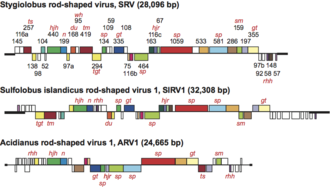Icerudivirus
Icerudivirus is a genus of viruses in the family Rudiviridae. These viruses are non-enveloped, stiff-rod-shaped viruses with linear dsDNA genomes, that infect hyperthermophilic archaea of the species Sulfolobus islandicus.[1][2] There are three species in the genus.[3]
SIRV1 and SIRV2 were produced by colony-cloned Sulfolobus islandicus strains. The two strains were isolated from samples taken in 1994 from different solfataric fields in Iceland, the Kverkfjöll and Hveragerði, which are separated by a distance of 250 km. These Icelandic solfataric acidic hot springs reach a temperature of 88 °C and pH 2.5.[7]
Virions are non-enveloped, consisting of a tube-like superhelix formed by dsDNA and the major structural protein, with plugs at each end to which three tail fibers are anchored. These tail fibers appear to be involved in adsorption onto the host cell surface and are formed by one of the minor structural proteins.[citation needed]
SIRV1 and SIRV2 are stiff rods of about 23 nm in width, but differing in length—SIRV1 is about 830 nm and SIRV2 is about 900 nm long. They present a central channel of approx. 6 nm that encapsidates the DNA genome. At each terminus of the rod there is a plug of approx. 48 nm in length and 6 nm in diameter that fills the terminal portion of the cavity, together with three tail fibres of approx. 28 nm in length.[citation needed]
A three-dimensional reconstruction of the SIRV2 virion at ~4 angstrom resolution has been obtained by cryo–electron microscopy.[8] The structure revealed a previously unknown form of virion organization, in which the alpha-helical major capsid protein of SIRV2 wraps around the DNA, making it inaccessible to solvent. The viral DNA was found to be entirely in the A-form, which suggests a common mechanism with bacterial spores for protecting DNA in the most adverse environments.
The genome is composed of linear dsDNA and ranges from 24 kb (ARV1) to 35 kb (SIRV2). The two strands of the linear genomes are covalently linked and, at both ends of the genome, there are inverted terminal repeats. The Sulfolobus rudiviruses size up to 32.3 kbp for SIRV1 and 35.8 kbp for SIRV2, with inverted terminal repeats of 2029 bp at the ends of the linear genome. The G+C content of both genomes is extremely low, of only 25%, whereas the genome of Sulfolobus solfataricus (the sequenced genome closest to the virus host) hits 37%.

